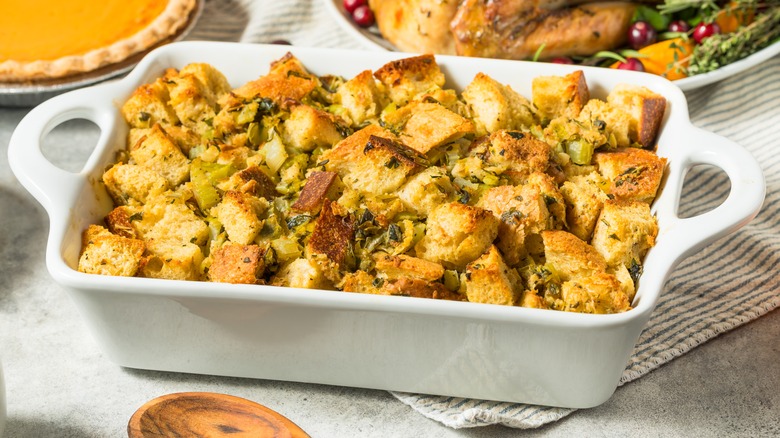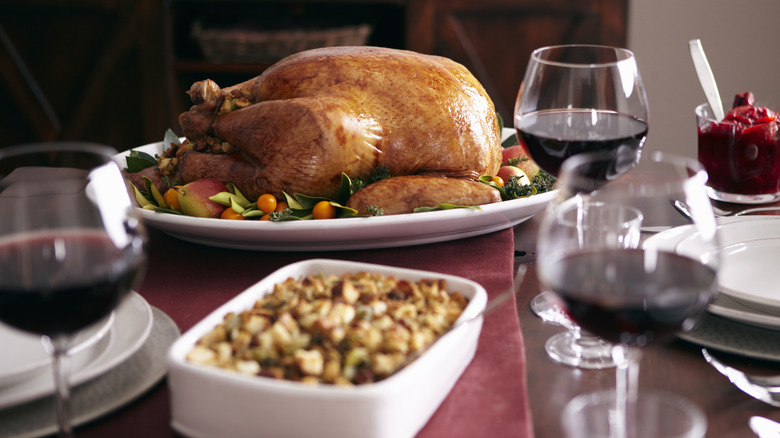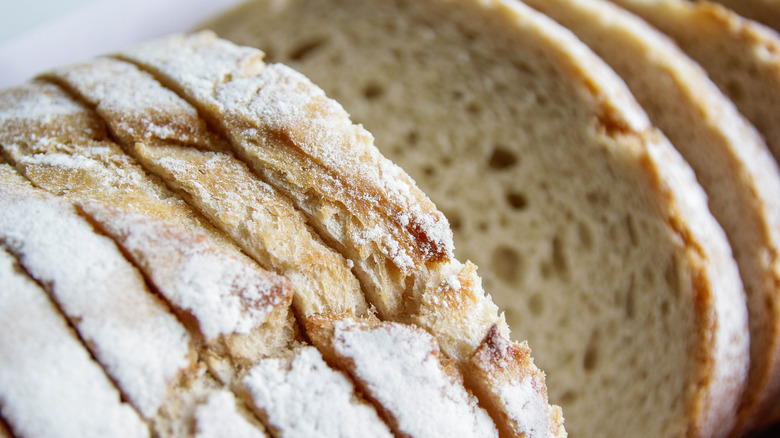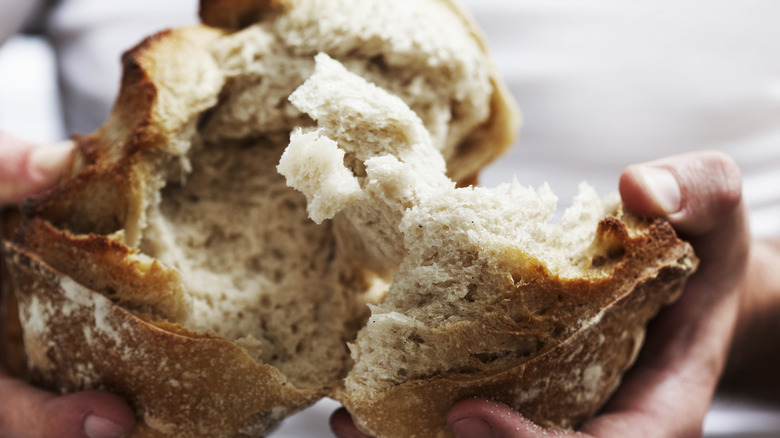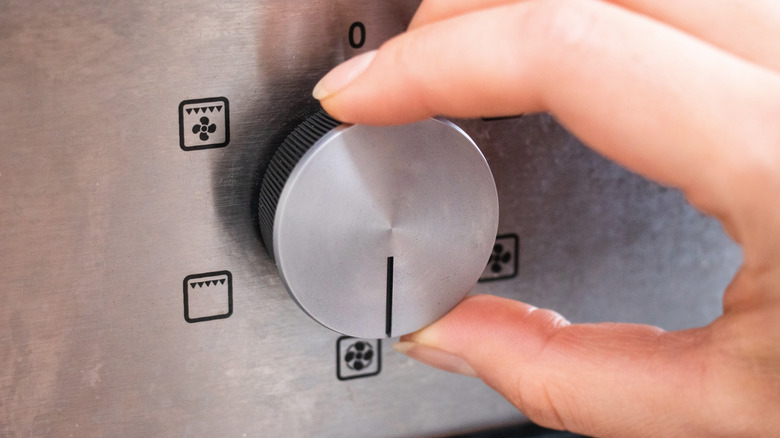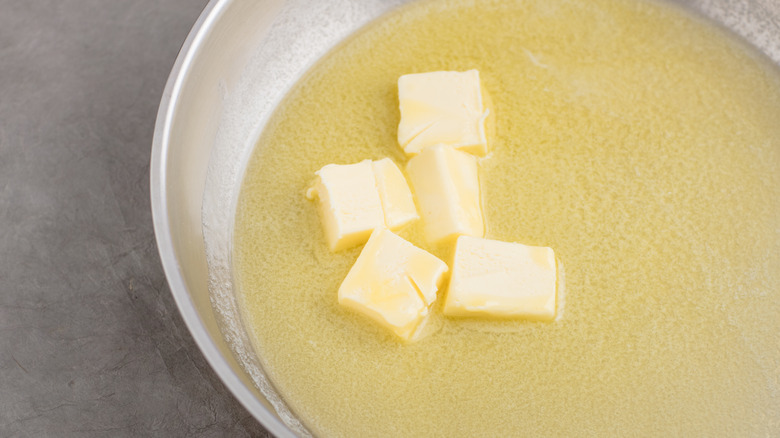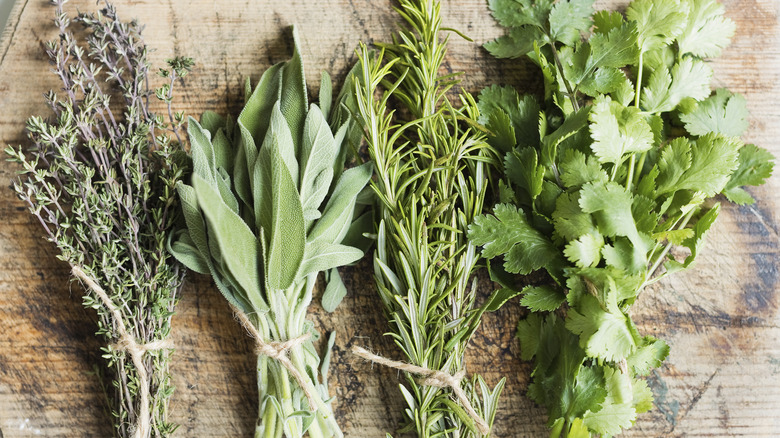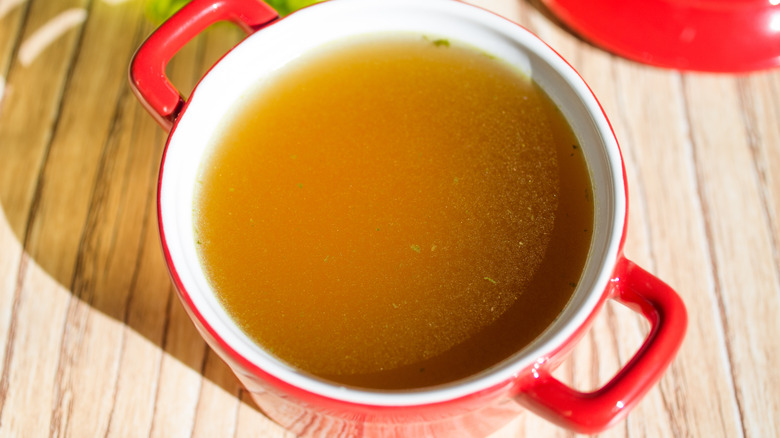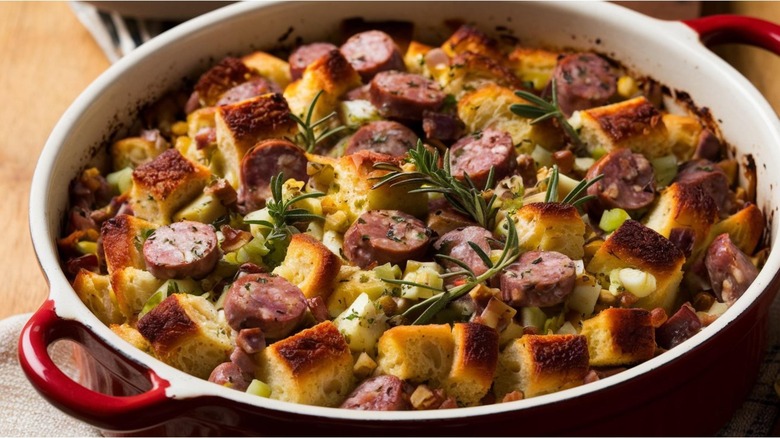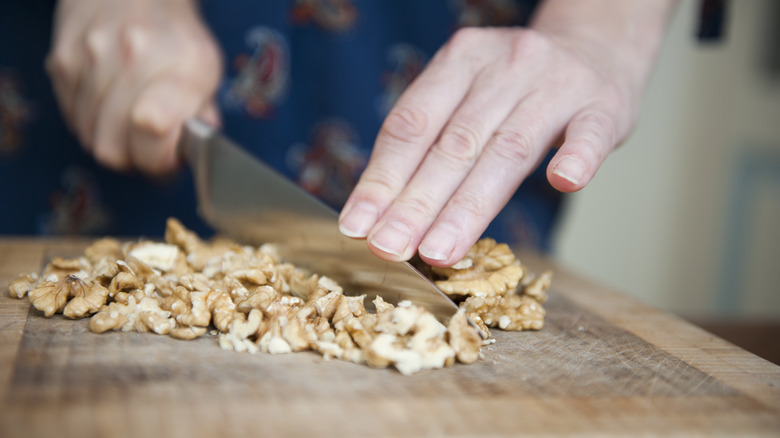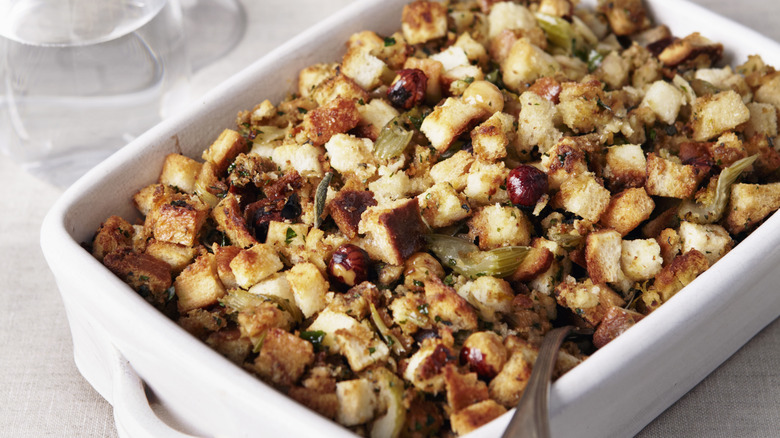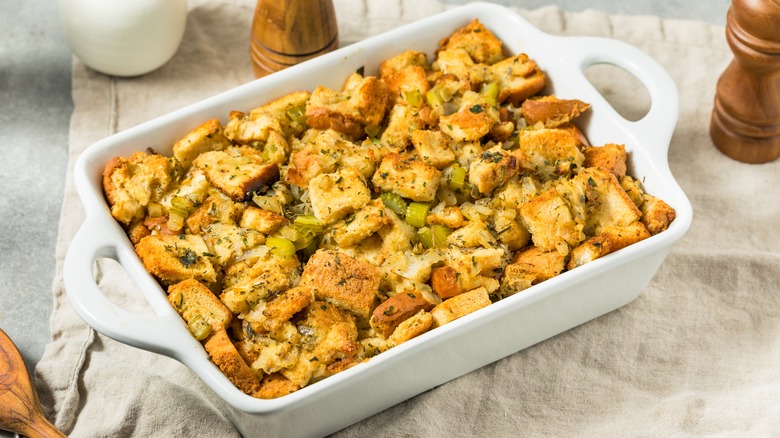12 Easy Tricks For Perfect Homemade Stuffing
No holiday feast is complete without a dish of rich and satisfying stuffing. Done right, this simple accompaniment to the meat and veggies can be one of the most memorable parts of a meal. When it comes to preparing homemade stuffing, there are a fair few variations in prep methods and ingredients of choice. Maybe you've stuck faithfully to your grandma's trusty recipe for years gone by, or perhaps you're looking to whip up something with a unique twist. Whatever you're aiming for, nailing the perfect balance of flavors and textures will require a little attention to detail, but by following a few simple tricks, you can ensure that your next batch of stuffing is the talk of the table.
In this guide, we're covering 12 essential tips for creating the ultimate homemade stuffing. From choosing the very best bread to incorporating flavorful additions like sausage or dried fruits, these handy techniques will result in a dish that's packed with depth, warmth, and crunch. If you've struggled with stuffing that's either too mushy or too dry, we're here to help. We've got all the tips you'll need to create that moreish crispy top and moist middle. So get ready to take notes and prepare to become a stuffing connoisseur. Your guests will thank you!
Always cook it outside of the turkey
A common mistake when making stuffing is cooking it inside the turkey. This approach may seem convenient, but it comes with some significant downsides. Stuffing cooked inside the bird often cooks unevenly, and this method can also be unsafe if the cavity doesn't reach a high enough internal temperature. For the stuffing to reach the safe threshold of 165 degrees Fahrenheit, you'll likely need to increase the overall cooking time, which means you risk overcooking the turkey itself, leaving it dry and less flavorful.
Cooking your stuffing in a separate dish, however, has several advantages. First, it allows for greater control over the texture. When baked in the oven on its own, the stuffing can develop a crispy, golden crust, which we think makes for a much more enjoyable dish. Furthermore, it's far easier to make a large quantity of stuffing when cooking it outside of the bird, since you're not trying to cram everything into the turkey cavity. So, for the best results, transfer your prepared stuffing mixture into a lightly greased baking dish (or dishes — we'll get to that later!) and bake uncovered until the top is a lovely golden brown.
Opt for a relatively firm type of bread
Choosing the right bread is essential for creating perfect stuffing. It's best to skip the flimsy white sandwich bread, as it tends to break down too quickly and create a mushy texture. Baguettes, on the other hand, can result in a texture that's much too chewy. Instead, opt for bread with a fairly sturdy structure, such as sourdough bread or an Italian loaf. These types of bread have a firmer crumb and can better absorb liquid without falling apart, making the perfect canvas to soak up the delicious seasonings in the stuffing. The bread serves as the foundation of your stuffing, so its flavor matters, too. Sourdough, for example, will bring a slight tang that'll pair wonderfully with savory herbs and rich broth.
The amount of bread you use in your stuffing recipe is also crucial to achieving the perfect texture. Too much bread, and the stuffing will turn out dry. Too little, and it could become overly soggy and not hold together well. The role of the bread here is to bind the other components of the stuffing together, and a good ratio to aim for is approximately double the amount of bread as you have other ingredients, like meat and vegetables.
Tear the bread rather than cutting
It might seem like a good idea to reach for a knife and slice your bread into perfectly uniform cubes, but tearing it by hand is actually a surprisingly effective trick for making better stuffing. Tearing the bread results in irregular, jagged edges that create more surface area for absorbing broth and other flavors. Plus, hand-torn bread pieces give the stuffing a much more hearty, rustic look.
As the stuffing cooks, the irregular edges of torn bread will soak up moisture more unevenly than perfect, uniform cubes of bread would. Some parts of the bread will catch in the oven and become browned and more crisp on the top, whilst other parts will remain moist and tender. This variation contributes to a more interesting texture, and every bite will have the perfect balance of crispness and softness.
So, it's absolutely worth spending a few minutes of extra time to create less uniform bread pieces. When prepping your bread, tear it up into roughly 1-inch pieces. This size is ideal for absorbing all of the delicious broth, butter, and seasonings without becoming too saturated.
Dry the bread out in the oven
If you've made stuffing before, you're probably familiar with the technique of using stale or dry bread, rather than a fresh loaf. This step is essential if you don't want an unappetizingly soggy stuffing. However, many people believe that simply leaving your bread out for a few days, until it seems stale, is the way to go. Unfortunately, this method is likely to yield disappointing results, since stale bread can still contain unwanted moisture.
When making stuffing, we need the bread to be as dry as possible. This will enable it to absorb as much liquid as possible when we add it to the accompanying stuffing ingredients, taking on plenty of flavor without becoming too soggy. The most effective way to dry the bread out is by baking it in the oven. Just place the bread chunks onto a metal rack or sheet pan, and bake at your oven's lowest temperature for around 45 minutes. After this, it should feel completely void of moisture and ever so slightly toasted. This is the optimal texture for stuffing.
Once dried, let the bread cool completely before combining it with your other ingredients. You can always do the baking step in advance if it is easier. Just store the oven-dried bread pieces in a resealable food bag until ready to use — for up to three days.
Don't skimp on the butter
Butter is one of the key ingredients in a stuffing. Without it, the dish will lack the depth and richness that makes it taste so delicious. Of course, reducing the amount of butter in your recipe can produce a lighter, lower-fat stuffing, but we highly recommend making the most of this indulgent ingredient!
Using a generous amount of butter is essential for achieving that perfect texture and taste, taking your stuffing from average to outstanding. Its role is to add both flavor and moisture, keeping the bread nice and tender. By adding lashings of creamy melted butter alongside the broth and eggs, you'll create stuffing with a luxurious melt-in-the-mouth quality. The butter also helps the top layer of the stuffing to develop a perfectly toasty, golden crust.
You'll need around 1 cup of butter for a typical batch of stuffing. Melt it down in a saucepan, and cook any aromatics like onions, leeks, and garlic directly in the fat. This can then be combined with the dried bread chunks, tossing well to ensure even coating, before adding the remaining ingredients. Opt for unsalted butter, which will make it easier to adjust the salt level of the dish to your taste. If you're looking for even more flavor, you can brown the butter slightly before adding it to add a slightly nutty, caramelized taste to the stuffing.
Use fresh herbs for a deeper flavor
The secret weapon to an exceptional stuffing, incorporating fresh herbs is a fantastic way to give the dish a deeper aromatic flavor. While dried herbs are great if that's all you have to hand, using fresh herbs will make a noticeable difference, bringing a brightness and color that dried herbs simply can't match.
The most commonly used herbs for stuffing include sage, thyme, rosemary, and parsley. Sage is the quintessential stuffing herb, lending its distinct earthy flavor and pairing perfectly with the other savory flavors of the dish. Thyme can add a subtle, lemony note that brightens things up, while rosemary provides a piney freshness. Parsley is perfect for adding a peppery finish, helping balance the richer flavors.
Before adding your assortment of herbs to the stuffing, give them a good rinse, then chop them finely to ensure they distribute evenly throughout the dish. A good rule of thumb is to use about three times more fresh herbs than you would dried, as fresh herbs are less concentrated. You can also saute the herbs with the butter and other aromatics to further enhance their aroma and infuse the butter with even more flavor.
Choose leeks over celery
When it comes to adding veggies to your stuffing, celery is a popular choice. This classic ingredient is great for adding flavor, but doesn't soften up quite as easily as some of the other stuffing components. If you prefer a slightly milder taste and a more tender texture, try swapping out the celery for some diced leek. This vegetable has a subtle aromatic quality, enhancing your stuffing without the bitterness that celery can sometimes impart.
Since leeks are less fibrous than celery, you'll find that they break down and combine with the other ingredients more readily. They'll work wonderfully alongside onions, mushrooms, garlic, and a range of fresh herbs. To prepare leeks, cut off the dark green tops and root ends, then slice the white and light green parts lengthwise, before chopping them into thin half-moon slices. It's easier to rinse leeks after chopping, since dirt and sand can get trapped in between their many layers. Just pop your chopped leeks into a large bowl of cold water, and swish them around with your hands to clean them before draining in a colander.
Before adding leeks to the stuffing, saute them in butter until they're soft and fragrant. This will help them to caramelize, enhancing their natural sweetness. If you're also using diced onion, toss this in at the same time.
Add richness with homemade turkey broth
A good broth can make a world of difference to the flavor of your stuffing, and whilst chicken or vegetable make perfectly acceptable options, switching these out for a homemade turkey broth can take stuffing to the next level.
Store-bought broth is always handy to have, but opt for a homemade broth, and you'll notice how much richer the flavors taste. Turkey broth is a natural fit if you're making your stuffing for a festive feast, and it's easy to prepare at home by slowly simmering turkey bones, vegetables, and herbs.
To make a basic turkey broth, use any parts of your leftover cooked turkey carcass. Add this to a large pot along with carrots, onions, and celery. Toss in some fresh herbs of your choice, like thyme, sage, and parsley, and some peppercorns for a hint of warmth. Cover everything with water, bring it to a boil, and then leave the mixture to simmer for about three hours. Once all of that natural goodness has infused into the broth, strain out the solids, and you're left with a golden liquid that's perfect for moistening your stuffing.
Add sausage for extra heartiness
If you prefer a stuffing that's meatier and more substantial, adding sausage is the way to go. This will bring a deeply savory element to the dish that fits brilliantly with the other herbs and aromatics. Plus, not only does this enhance the taste, but it also adds plenty of protein, making the stuffing more filling and satisfying.
Choose a high-quality sausage meat that matches the flavor profile you want. Mild Italian pork sausage is a great choice, with its high fat content moistening the bread wonderfully. For a spicier twist, you can always opt for a spicy chorizo, or to keep things lighter, perhaps some chicken or turkey sausage. If the sausage comes in casing, make sure to remove this prior to cooking, so the meat can break down easily and distribute itself throughout the stuffing.
In Bobby Flay's famous sausage stuffing recipe, he first browns Italian sausage in a pan before setting it aside, leaving behind all of the flavorful fat that the meat released during cooking. This is an essential component that he then uses to saute the medley of vegetables and garlic in, which, of course, makes them taste incredible. Then, the meat and veg are combined with the bread, eggs, and broth, ensuring every element is infused with the richness of the sausage.
Add chopped nuts or dried fruits
For an added layer of crunch and natural sweetness, try adding some chopped nuts or dried fruits to your stuffing mixture. This is a wonderful way to make your recipe unique and customize it to your taste. Plus, the contrast between the savory bread base and the sweetness or nuttiness of these add-ins can make everything a little bit more well-rounded.
Chopped nuts like walnuts, pecans, or hazelnuts are excellent options for a rich, earthy crunch. Toasting the nuts lightly before adding them to the stuffing will enhance their natural flavors, too. Make sure to chop them finely, so they'll end up scattered throughout the entire dish evenly. Dried fruits such as cranberries, raisins, apricots, or cherries introduce a pop of sweetness and juiciness that makes a delicious complement to the savory elements. They're great for adding some festive color to the dish, too. Soaking the dried fruits in a bowl of boiling water or broth before adding them can help to soften them up and prevent them from becoming overly chewy during baking.
If dried fruits and nuts aren't your thing, there are plenty of other tasty add-in options that can add sweetness and crunch to your stuffing. Fresh apples pair beautifully with sausages, sage, and thyme, whilst crushed pretzels are an amazing ingredient for amping up the crunch.
Don't be too heavy handed when pressing it into the baking dish
When you're mixing the stuffing up and transferring it to the baking dish, it's important that you don't accidentally break the bread pieces down any further or pack the mixture down too tightly. Of course, it's good to ensure that the bread gets thoroughly mixed with the other ingredients, but if you're too heavy-handed, it might start to become mushy or fall apart into smaller crumbs. Using a large metal spoon or spatula and a folding action is your best bet to mix everything evenly without damaging the integrity of the bread.
Then, when you transfer the stuffing to the baking dish, use a light hand here, too. Spoon the mixture in carefully and distribute it evenly. Now, you can press down gently to lightly pack everything into the dish without compacting or mushing anything too much. This way, your stuffing should cook evenly and achieve the perfect balance of crispiness and tenderness.
Bake it smaller, shallower dishes
The size of your baking dish can greatly impact the outcome of your stuffing, too. A large, deep dish will certainly save you some clean-up time, but baking your stuffing in multiple small, shallow dishes can yield far better results. A shallower dish allows for more surface area, which means more of that delicious, crispy top layer that everyone loves. It also helps the stuffing to cook evenly, avoiding a mushy center or burnt edges.
The crispiest part of a freshly baked dish of stuffing tends to be around the edges, where the stuffing meets the dish, and everything browns up wonderfully during cooking. This is why splitting the stuffing between two or more dishes is always an excellent idea. More dishes mean you have a greater number of edges and, therefore, more of that top-tier golden crispiness. Greasing your dishes with a little butter or oil before adding the stuffing mixture is another great way to promote browning while preventing sticking, too.
